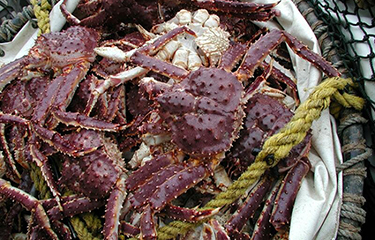The Southeast Alaska red and blue king crab fisheries will remain closed for commercial harvests in the 2023-24 season following dismal population surveys again this year. Stock assessment models determined the biomass across the U.S. state at 188,899 pounds, which fell below the threshold limit of 200,000 pounds that would warrant conducting the fisheries.
The closure comes as no surprise to those managing and participating in the on-again, off-again fishery, as the lack of sufficient biomass has kept the fleet from splashing pots since 2017. But Adam Messmer, lead king and tanner crab biologist with the Alaska Department of Fish and Game, said prospects look good for a fishery again next year.
“We are in kind of an uptick,” Messmer said. “The number of legal crab in this year’s survey went up by 9 percent and the mature crab went up by 20 percent. The matures are one molt away from becoming legal.”
The expectation is that this year’s mature crab will recruit into the biomass as legal and trigger the opening of a fishery in the 2024-2025 season. By regulation, the minimum size limit across the carapace is 7 inches, and the season would open 24 October.
In the 2017-2018 season, the last year the fishery was open, crabbers landed 120,000 pounds of red and blue king crab. Ex-vessel crab prices hit an average USD 10.00 (EUR 9.34) per pound that season. According to historical records with ADF&G, the fishery hit its high point in 1997 with a harvest of 429,788 pounds. Ex-vessel prices that year averaged USD 3.91 per pound (EUR 3.65), putting fleet revenues for the 81 permit holders at around USD 1.7 million (EUR 1.6 million).
Landings since then have been sporadic as biomass rises and falls. Ex-vessel prices in markets that absorb the relatively small volume put out by the Southeast fishery have increased from around USD 3.50 (EUR 3.27) per pound to USD 10 per pound in recent years.
Reporting by Charlie Ess
Photo courtesy of NOAA







